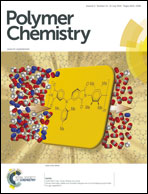Benzyl β-malolactonate polymers: a long story with recent advances
Abstract
Poly(benzyl β-malolactonate) (PMLABe) is an aliphatic renewable, biocompatible, biodegradable, hydrophobic polyester of the poly(hydroxyalkanoate) (PHA) family. Along with the hydrophilic parent poly(β-malic acid) (PMLA), PMLABe and PMLA have been studied as materials for biomedical applications. Herein, advances on the synthesis of benzyl β-malolactonate (MLABe) and the related alkyl β-malolactonates (MLARs), PMLABe homopolymers and copolymers, are reviewed. Focus is placed on the ring-opening polymerization (ROP) of MLABe and on copolymers of MLABe, with relevant data on the performances of the initiating systems and on the PMLABes molecular characteristics, along with detailed mechanistic insights, being reported.


 Please wait while we load your content...
Please wait while we load your content...